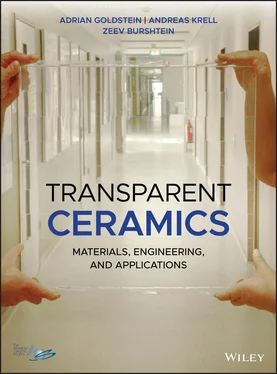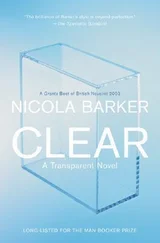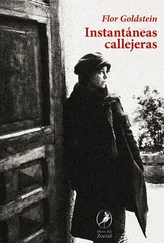The advent of the Lucalox, and then its commercial success, immediately triggered great interest in transparent ceramics. New materials and processing approaches, along with considerable basic knowledge, resulted in efforts to develop new transparent ceramics.
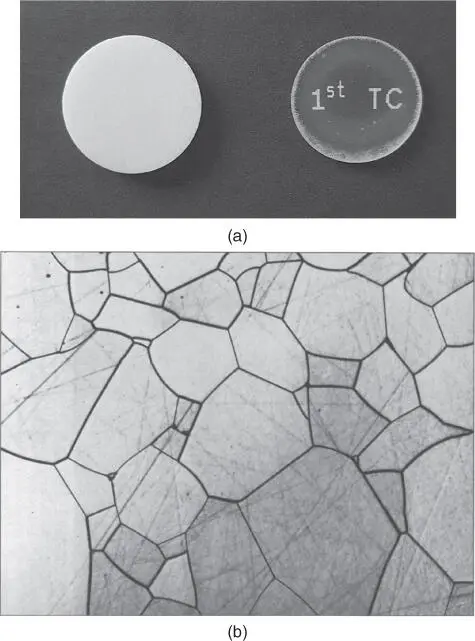
Figure 1.4 First translucent, all-crystalline ceramic: imaging and microstructure (a) White opaque regular alumina ceramic (left) translucent “Lucalox” (GE) ceramic alumina (right) and (b) microstructure (center grain = 95 micron) of translucent part shown above.
1.5.3 A Brief Progress History of All-Crystalline Transparent Ceramics
The Lucalox alumina described in Section 1.5.2was the first transparent ceramic devoid of any glassy phases. It has been manufactured by the powder compacts sintering method. One may rightfully define the date of that development completion, roughly in 1960, as the start of transparent ceramics research and development era.
Progress in this domain involved development of new materials and introduction of new processing and characterization methods. Some contributions were of a basic nature, being relevant for the general ceramics science and engineering.
One may cite magnesium oxide MgO and magnesium fluoride MgF 2(1962), perovskite lead zirconate titanate (PLZT, PbZr xTi 1−xO 3) (1967), and magnesium spinel MgAl 2O 4(1969) among the first transparent ceramics developed (lab scale) after Lucalox. Unlike alumina, the lattice of these materials is cubic, thus allowing high transmission levels, quite close to that of glass. Various other passive transparent ceramics, like aluminum oxynitride (ALON, (AlN) x(Al 2O 3) 1−x), or diamond C, were achieved in later years (eighties through nineties). Transparent ceramic Neodymium-doped yttrium–aluminum garnet Nd : Y 3Al 5O 12(Nd : YAG abbreviated) [I6] ( Figure 1.6) was developed in the early 1990s; transparent zirconia ZrO 2(allowing special lenses fabrication) was produced more recently. The progress in the 1960s was accomplished mostly by the efforts of some American private companies (indeed under governmental financial backing) like General Electric, Avco, Raytheon, Eastman-Kodak, Alpha, and Motorola, or by national research organizations like Sandia, North Carolina State University, and Missouri-Rolla University (PLZT). As of the 1980s, transparent ceramics development spread throughout the world. Most remarkable results have been achieved in Japan, Germany, France, Russia, Italy, Poland, China, Singapore, and Israel. Each material has also been characterized by its specific structure and non-spectral properties, allowing widening the applications range for which the transparent ceramics became useful. In some cases, it became more attractive than the competing glasses or single crystals. For example, magnesium spinel MgAl 2O 4was found preferable for fabrication of armor windows strike-faces and IR sensor-protective covers; PLZT (PbZr xTi 1−xO 3) allowed the production of goggles protective against atomic explosion flash. Materials like calcium fluoride CaF 2, YAG (Y 3Al 5O 12) and yttria Y 2O 3were able to accommodate rare-earth (RE)-type cations in crystallographic sites of suitable symmetry and size. It allowed fabrication of laser light gain media, phosphors, scintillators, and artificial jewelry. Zinc sulfide ZnS functions as a good window for light sensors operating in the 8–14 μm range, which is even resilient as dome covers for forward looking IR cameras of aircrafts, flying at moderate speed. A more detailed list of transparent ceramic materials is given in Chapter 4. Applications are further discussed in Chapter 5.
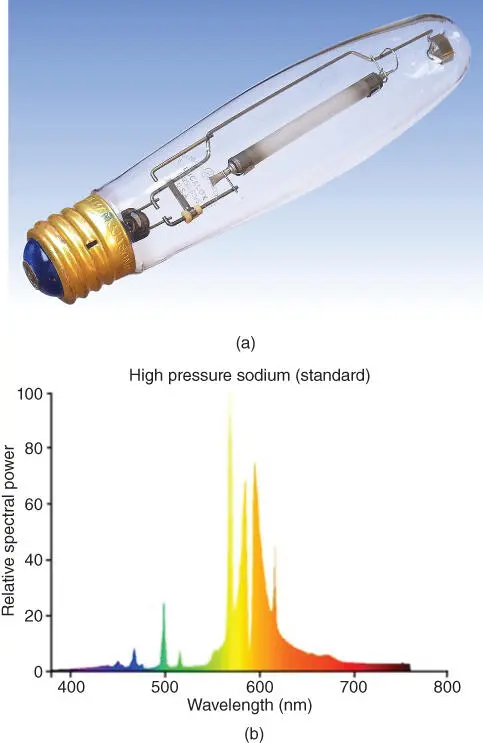
Figure 1.5 Lamp (high pressure Na vapor) including vapors, envelope made of translucent Lucalox alumina. From GE advertising material. (a) Product image and (b) spectral composition of light emitted by lamp of panel (a).
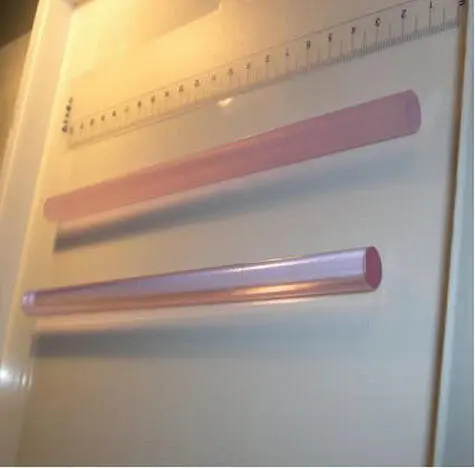
Figure 1.6 Nd:YAG rod-shaped ceramic gain media for solid-state lasers. Top: rod etched surface and bottom: rod polished after etching.
Source: Reproduced with permission from R. Feldman et al., Israel [F4].
Processing progress ( Chapter 3) was achieved by a number of sometimes interacting ways. One way was multiplication of basic fabrication methods. Some methods exhibited a broad scope of usability; others were developed specifically for transparent ceramics. The general pulsed electric current sintering (PECS) method allowed reduction of sintering temperatures. For instance, spinel MgAl 2O 4could be densified at around 1200 °C under a pressure of 400 MPa, or even more so, under 1000 °C and hot pressing at ultrahigh pressure (2–8 GPa). At such high pressures, spinel densification could be obtained at as low as 550 °C. Consequently, remnant pores size was of only a few micrometers, providing optical transparency to samples that still had some 2 vol% porosity (usually, transparency is lost for over ∼200 ppm porosity if pores size is in the submicrometer or larger range). Direct conversion of graphite to transparent diamond became feasible at 20 GPa. These methods are improved variants of the powder sintering approach, the one used exclusively in early production of transparent ceramics. Over time, other approaches, like bulk chemical vapor deposition (CVD) and bulk sol–gel reaction, allowed fabrication of exotic components, such as polycrystalline diamond domes and transparent cubic alumina γ-Al 2O 3. More recently, fully controlled crystallization made possible the transformation of initially glassy samples into transparent ceramics; for example, barium oxy-aluminate Ba 2Al 4O 7. A large step toward extension of the usable materials from cubic to those of lower symmetry has been accomplished by the development of particles orientation by “slip”-casting under a magnetic field. Scattering owed to birefringence in non-cubic dense ceramics could be massively reduced by fabrication of nanograined ceramics and glass-ceramics. Solid-state conversion of polycrystalline ceramics into single crystals allowed fabrication of laser gain media with improved optical characteristics. For that purpose, preparation of ultrapure spheroidal particles by flame spray pyrolysis, or via laser vaporization, deserve a special mention. An important step toward full densification of sintered powders was the realization that shaping of the green bodies is crucial. To achieve that goal, new powder synthesis and processing methods were introduced. One may also cite attrition and jet-milling, supercritical conditions fluid expansion, or sprayed-suspension freeze drying. Pressure slip casting, gel-casting magnetic-pulsed uniaxial pressing, or centrifugal deposition was used in order to shape and consolidate powders into compact green bodies exhibiting low average pore size at even distribution. Progress was made also regarding the material characterization during various stages of the fabrication processes ( Chapter 3).
Конец ознакомительного фрагмента.
Текст предоставлен ООО «ЛитРес».
Прочитайте эту книгу целиком, на ЛитРес.
Безопасно оплатить книгу можно банковской картой Visa, MasterCard, Maestro, со счета мобильного телефона, с платежного терминала, в салоне МТС или Связной, через PayPal, WebMoney, Яндекс.Деньги, QIWI Кошелек, бонусными картами или другим удобным Вам способом.
